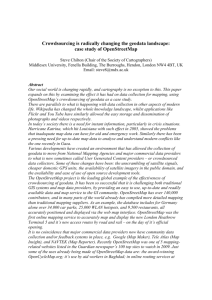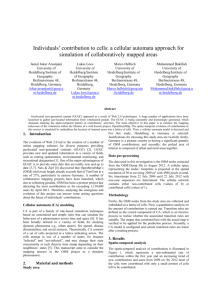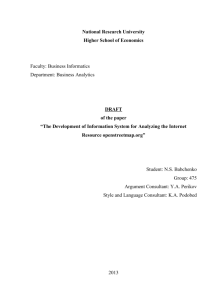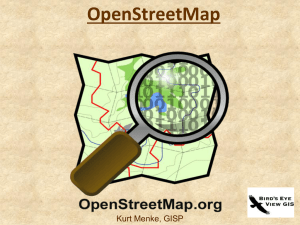Call for Book Chapter Proposal Submission
advertisement
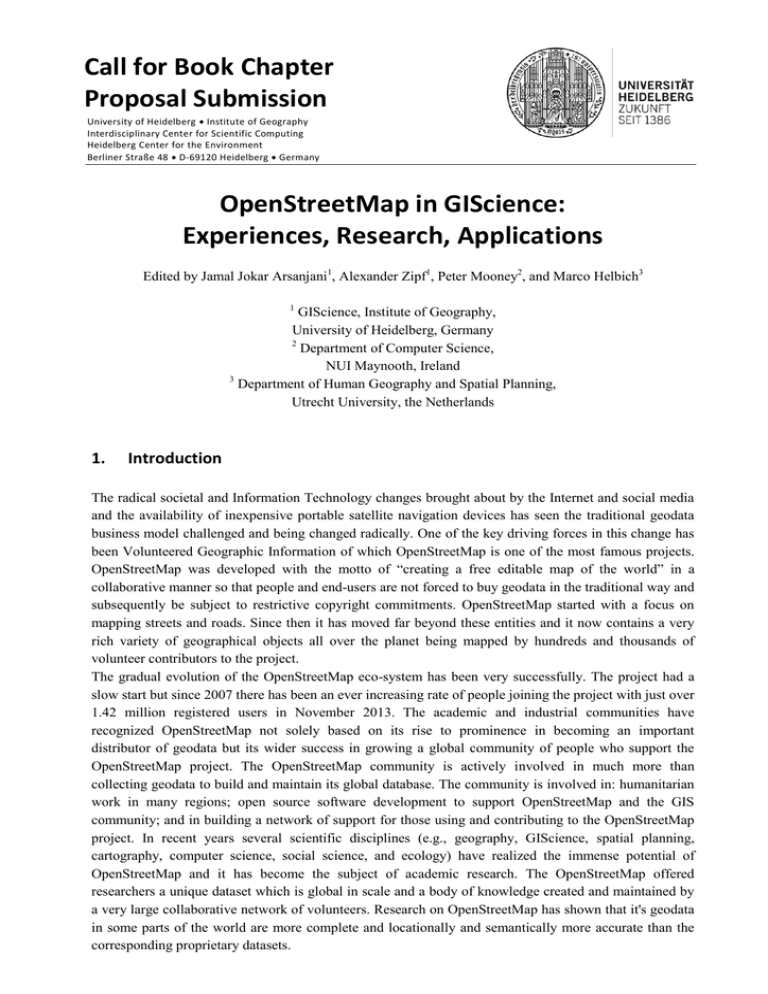
Call for Book Chapter Proposal Submission University of Heidelberg Institute of Geography Interdisciplinary Center for Scientific Computing Heidelberg Center for the Environment Berliner Straße 48 D-69120 Heidelberg Germany OpenStreetMap in GIScience: Experiences, Research, Applications Edited by Jamal Jokar Arsanjani1, Alexander Zipf1, Peter Mooney2, and Marco Helbich3 1 GIScience, Institute of Geography, University of Heidelberg, Germany 2 Department of Computer Science, NUI Maynooth, Ireland 3 Department of Human Geography and Spatial Planning, Utrecht University, the Netherlands 1. Introduction The radical societal and Information Technology changes brought about by the Internet and social media and the availability of inexpensive portable satellite navigation devices has seen the traditional geodata business model challenged and being changed radically. One of the key driving forces in this change has been Volunteered Geographic Information of which OpenStreetMap is one of the most famous projects. OpenStreetMap was developed with the motto of “creating a free editable map of the world” in a collaborative manner so that people and end-users are not forced to buy geodata in the traditional way and subsequently be subject to restrictive copyright commitments. OpenStreetMap started with a focus on mapping streets and roads. Since then it has moved far beyond these entities and it now contains a very rich variety of geographical objects all over the planet being mapped by hundreds and thousands of volunteer contributors to the project. The gradual evolution of the OpenStreetMap eco-system has been very successfully. The project had a slow start but since 2007 there has been an ever increasing rate of people joining the project with just over 1.42 million registered users in November 2013. The academic and industrial communities have recognized OpenStreetMap not solely based on its rise to prominence in becoming an important distributor of geodata but its wider success in growing a global community of people who support the OpenStreetMap project. The OpenStreetMap community is actively involved in much more than collecting geodata to build and maintain its global database. The community is involved in: humanitarian work in many regions; open source software development to support OpenStreetMap and the GIS community; and in building a network of support for those using and contributing to the OpenStreetMap project. In recent years several scientific disciplines (e.g., geography, GIScience, spatial planning, cartography, computer science, social science, and ecology) have realized the immense potential of OpenStreetMap and it has become the subject of academic research. The OpenStreetMap offered researchers a unique dataset which is global in scale and a body of knowledge created and maintained by a very large collaborative network of volunteers. Research on OpenStreetMap has shown that it's geodata in some parts of the world are more complete and locationally and semantically more accurate than the corresponding proprietary datasets. Call for Chapters: OpenStreetMap in GIScience: Experiences, Research, Applications 2. Objectives and Scope The main objective of the intended edited volume is to seek experiences using OpenStreetMap including cutting edge scientific investigations on OpenStreetMap from different geodata and users perspectives as well as developed and under development applications benefiting from OpenStreetMap and the advancement and promotion of OpenStreetMap in GIScience. Due to the complexity, inter- and transdisciplinary nature of collaborative mapping projects such as OpenStreetMap, submissions of chapter proposals from an extensive range of scientific disciplines such as geography, cartography, computer science, statistics, geographic information science, sociology, urban planning, environment planning, transportation, and civil engineering are highly welcome. The edited book is scheduled to be published by Springer in its leading series in GIScience “Lecture Notes in Geoinformation and Cartography” series, edited by William Cartwright, George Gartner, Liqiu Meng, and Michael P. Peterson. For more detailed information about this series, we refer to the Springer webpage, accessible via the following link http://www.springer.com/series/7418. The book seeks to build a firm foundation for research work focused on integrating OpenStreetMap. Chapters should address the following research topics, however not limited to: a) b) c) d) e) f) g) h) i) 3. State-of-the-art and cutting-edge approaches for data quality analysis and data fusion techniques in OpenStreetMap and other Volunteered Geographic Information sources, Investigations on understanding OpenStreetMap contributors and the nature of their contributions, Identification of patterns of contributions and contributors in OpenStreetMap, Desktop, online, and mobile applications of OpenStreetMap in different domains (e.g. 3D, routing, traffic, disaster management, health, crime, history, ecology, etc.), Mining value-added knowledge and information from OpenStreetMap, Limitations and possibilities in the analysis of OpenStreetMap data, Integration of OpenStreetMap with commercial and non-commercial geodatasets, Emergence and evolution of OpenStreetMap across the world, OpenStreetMap’s contribution to GIScience. Submission and Important Dates All chapter proposals will be evaluated by a committee of experts before author(s) are being invited to submit their full book chapters. Chapters must not have been published elsewhere. Unpublished conference presentations and extended conference works are acceptable. Published conference presentations (e.g., in a proceedings volume) may be acceptable if the full copyright can be transferred. Submission procedure for chapter proposals (abstracts): Length: 1-2 pages Format: Microsoft Word or Adobe PDF Figures/Tables: Must be legible (<300 dpi are accepted at this stage) 3 Call for Chapters: OpenStreetMap in GIScience: Experiences, Research, Applications Important dates: January 31, 2014: February 28, 2014: May 30, 2014: July 30, 2014: September 30, 2014: December, 2014: Chapter proposal submission deadline Notification of chapter acceptance/rejection and invitation to submit full chapters Final chapter submission deadline Acceptance/rejection notification sent to author(s) Final revised chapter submission deadline Expected publication of book General: Submissions must include the author's names, affiliation, mailing address, and e-mail address. In the case of multiple authors, all names, addresses, etc., must accompany the submission and a corresponding author should be identified. If submitting a published conference presentation (e.g., one that has already appeared in a proceedings volume), the author(s) must provide proof that the article's full copyright can be transferred. Submissions must be sent as an e-mail attachment to Jamal Jokar Arsanjani using the e-mail address listed above. Notification: Notification regarding the status of each proposal will be sent by February 28, 2014 to all those who submitted a chapter proposal. At that time, authors whose chapter proposals have been accepted will also be e-mailed guidelines regarding full book chapter preparation. Post-acceptance information: The full book chapter deadline is May 30, 2014. Following receipt, full chapters will be sent out for double-blind review. The Editors will make the final decision regarding final acceptance of each book chapter. All chapters with revision requests (if necessary) need to be completed by September 30, 2014. Inquiries should be directed to Dr. Jamal Jokar Arsanjani GIScience, Institute of Geography University of Heidelberg Berliner Straße 48 D-69120 Heidelberg, Germany http://www.geog.uni-heidelberg.de/personen/gis_arsanjani.html jokar.arsanjani@geog.uni-heidelberg.de Tel.: +49(0)6221 / 54 5572 Fax: +49(0)6221 / 54 4529 Heidelberg, Nov 14, 2014 4


